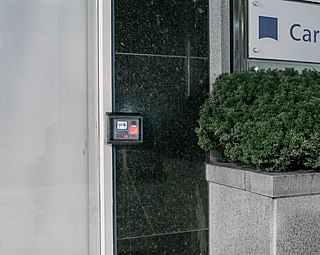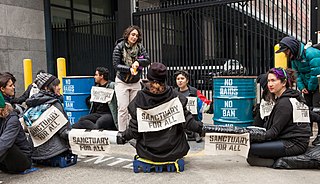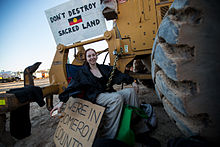
Locksmithing is the science and art of making and defeating locks. Locksmithing is a traditional trade and in many countries requires completion of an apprenticeship. The level of formal education legally required varies from country to country from none at all, to a simple training certificate awarded by an employer, to a full diploma from an engineering college, in addition to time spent working as an apprentice.

In physical security and information security, access control (AC) is the selective restriction of access to a place or other resource, while access management describes the process. The act of accessing may mean consuming, entering, or using. Permission to access a resource is called authorization.

Handcuffs are restraint devices designed to secure an individual's wrists in proximity to each other. They comprise two parts, linked together by a chain, a hinge, or rigid bar. Each cuff has a rotating arm which engages with a ratchet that prevents it from being opened once closed around a person's wrist. Without a key, handcuffs cannot be removed without specialist knowledge, and a handcuffed person cannot move their wrists more than a few centimetres or inches apart, making many tasks difficult or impossible.

Earth First! is a radical environmental advocacy group that originated in the Southwestern United States. It was founded in 1980 by Dave Foreman, Mike Roselle, Howie Wolke, Bart Koehler, and Ron Kezar. Today there are Earth First groups around the world including ones in Australia, Belgium, Canada, the Czech Republic, France, Germany, India, Ireland, Italy, Mexico, the Netherlands, Nigeria, New Zealand, the Philippines, Poland, Slovakia, Spain, the United Kingdom, and the United States.

A protest is a public act of objection, disapproval or dissent against political advantage. Protests can be thought of as acts of cooperation in which numerous people cooperate by attending, and share the potential costs and risks of doing so. Protests can take many different forms, from individual statements to mass political demonstrations. Protesters may organize a protest as a way of publicly making their opinions heard in an attempt to influence public opinion or government policy, or they may undertake direct action in an attempt to enact desired changes themselves. When protests are part of a systematic and peaceful nonviolent campaign to achieve a particular objective, and involve the use of pressure as well as persuasion, they go beyond mere protest and may be better described as civil resistance or nonviolent resistance.
Civil disorder, also known as civil disturbance, civil unrest, civil strife, or turmoil, are situations when law enforcement struggle to maintain public order or tranquility.

A lock is a mechanical or electronic fastening device that is released by a physical object, by supplying secret information, by a combination thereof, or it may only be able to be opened from one side, such as a door chain.

In climbing and mountaineering, belaying comprises techniques used to create friction within a climbing protection system, particularly on a climbing rope, so that a falling climber does not fall very far. A climbing partner typically applies tension at the other end of the rope whenever the climber is not moving, and removes the tension from the rope whenever the climber needs more rope to continue climbing. The belay is the place where the belayer is anchored, which is typically on the ground, or on ledge but may also be a hanging belay where the belayer themself is suspended from an anchor in the rock on a multi-pitch climb.

A wheel clamp, also known as wheel boot, parking boot, or Denver boot, is a device that is designed to prevent motor vehicles from being moved. In its most common form, it consists of a clamp that surrounds a vehicle wheel, designed to prevent removal of both itself and the wheel.

Roof and tunnel hacking is the unauthorized exploration of roof and utility tunnel spaces. The term carries a strong collegiate connotation, stemming from its use at MIT and at the U.S. Naval Academy, where the practice has a long history. It is a form of urban exploration.

A bicycle lock is a security device used to deter bicycle theft, either by simply locking one of the wheels or by fastening the bicycle to a fixed object, e.g., a bike rack.

A latch or catch is a type of mechanical fastener that joins two objects or surfaces while allowing for their regular separation. A latch typically engages another piece of hardware on the other mounting surface. Depending upon the type and design of the latch, this engaged bit of hardware may be known as a keeper or strike.

An electronic lock is a locking device which operates by means of electric current. Electric locks are sometimes stand-alone with an electronic control assembly mounted directly to the lock. Electric locks may be connected to an access control system, the advantages of which include: key control, where keys can be added and removed without re-keying the lock cylinder; fine access control, where time and place are factors; and transaction logging, where activity is recorded. Electronic locks can also be remotely monitored and controlled, both to lock and to unlock.

The Panama Canal locks are a lock system that lifts ships up 85 feet to the main elevation of the Panama Canal and down again. The original canal had a total of six steps for a ship's passage. The total length of the lock structures, including the approach walls, is over 1.9 miles (3 km). The locks were one of the greatest engineering works ever to be undertaken when they opened in 1914. No other concrete construction of comparable size was undertaken until the Hoover Dam, in the 1930s.

A surfboard lock is a device or a mechanism for securing a surfboard to prevent theft or loss. Typically surfboard locks attach to some part of the surfboard, such as the leash plug or center fin box slot. Alternately, some locking devices clamp or strap around the surfboard. Once the board is secured, the locking device attaches to some hard point like a vehicle or a non-movable object.

Port Militarization Resistance (PMR) is an anti-war movement in the United States. The movement began in May 2006, in Olympia, Washington, but also has chapters in Tacoma, Washington, Grays Harbor, Washington, and the Mid-Atlantic region. Port Militarization Resistance is also the name of the strategy employed by this movement. Adherents of the PMR strategy advocate an end to the Iraq War and the War in Afghanistan to be accomplished through making civilian-owned ports inaccessible to the military, with less emphasis on persuading elected officials to abandon the war. PMR organized high-profile protests at the Port of Olympia and the Port of Tacoma in 2006, 2007, 2008, and 2009.

A door chain, security chain, or security door chain or chain door interviewer consists of a small chain attached to the door frame, which attaches to a track on the door for security purposes. It is a type of lock that is often used along with other types of locks to secure a door. They are commonly used on hotel and motel room doors.

A sleeping dragon is a maneuver used by protesters to hinder their removal from a protest site. A series of protesters are handcuffed together through PVC pipe, which prevents police from simply using bolt cutters to break the handcuffs. Advanced variations include covering the PVC pipe with elements which might make it more difficult to break. Examples include chicken wire, tar, and duct tape. Another variation is filling a barrel with concrete and putting the PVC pipe through the barrel such that it cannot be accessed without first destroying all of the concrete.

An electromagnetic lock, magnetic lock, or maglock is a locking device that consists of an electromagnet and an armature plate.
Lock On is a genre of street art, where artists create installations by attaching sculptures to public furniture using lengths of chain and old bike locks. The installations themselves are referred to as "a Lock On" (singular) or "Lock Ons" (plural).



















